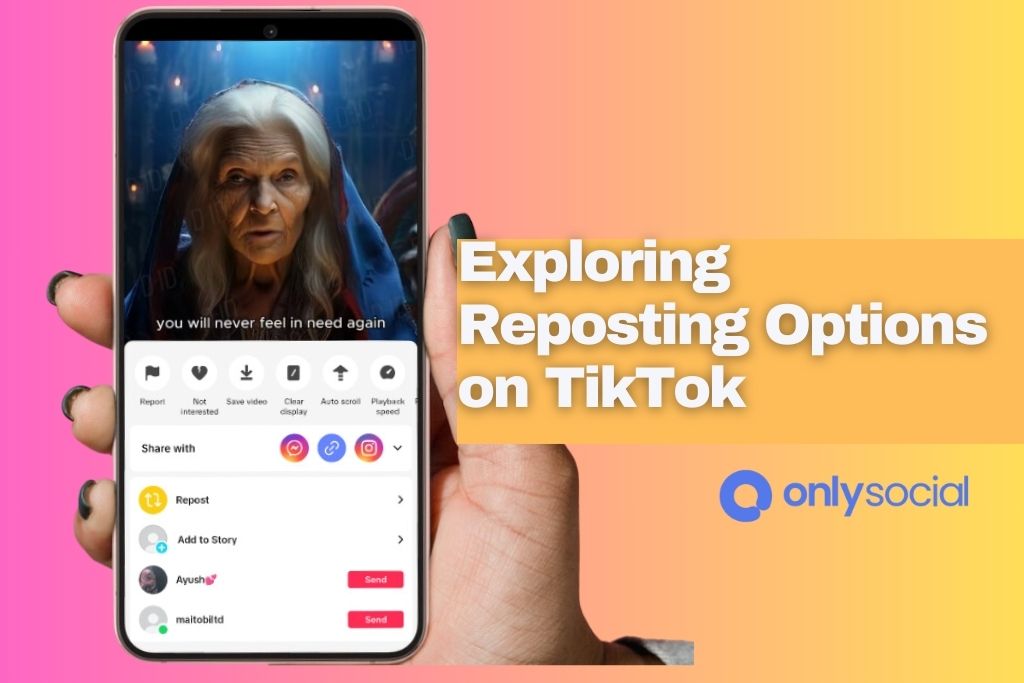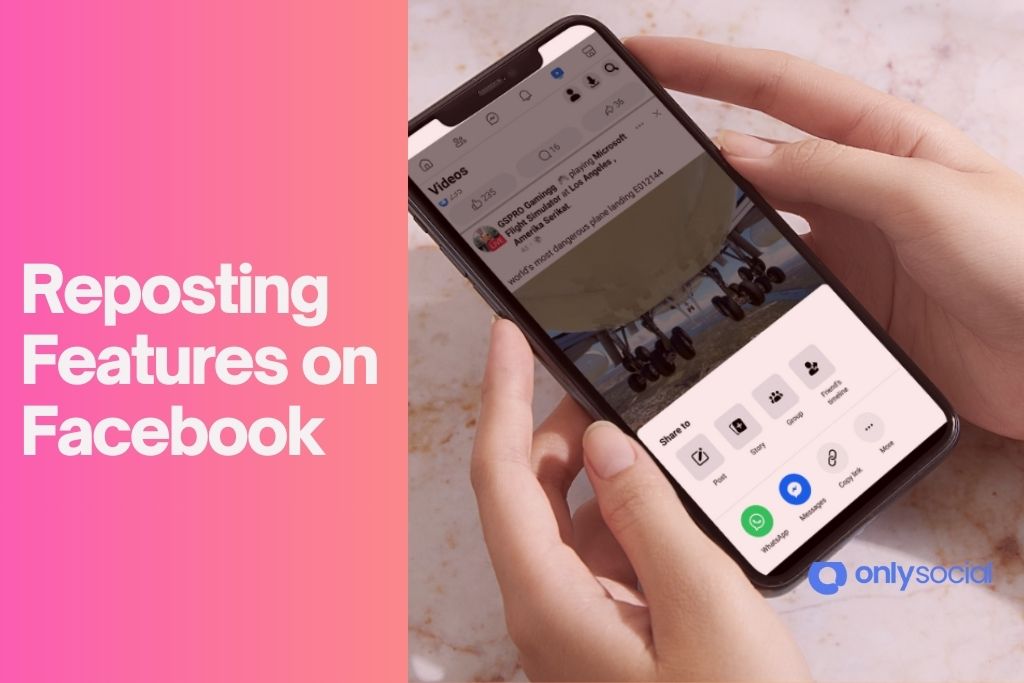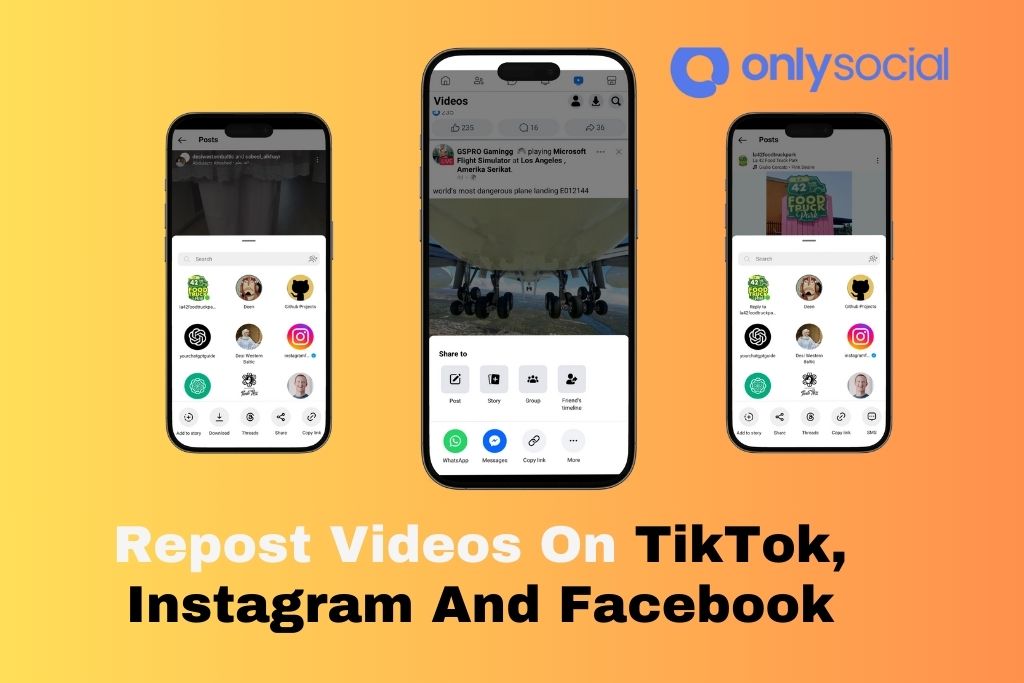Reposting videos on popular social media platforms like TikTok, Instagram, and Facebook has become increasingly common in recent years. This comprehensive guide will help you effectively and ethically repost videos on these platforms.
By understanding the terms and conditions of each platform and exploring different reposting options, you can navigate the process seamlessly.
Additionally, we’ll share tips and tricks for maximizing engagement by properly attributing content when reposting on these social media platforms.
Table of Contents
- 1 Understanding the Terms and Conditions
- 2 Exploring Reposting Options on TikTok
- 3 Reposting Videos on Instagram: Step-by-Step Guide
- 4 Navigating the Reposting Features on Facebook
- 5 Using Third-Party Apps for Reposting on TikTok
- 6 Reposting Videos on Instagram: Tips and Tricks
- 7 Ensuring Proper Attribution When Reposting on Facebook
- 8 Maximizing Engagement Through Reposting on Social Media Platforms
- 9 BONUS
- 10 Frequently Asked Questions
- 10.1 Can I Repost Videos on TikTok Without Violating the Platform’s Terms and Conditions?
- 10.2 Are there any restrictions on the type of videos that can be reposted on Instagram?
- 10.3 How Can I Repost Videos on Facebook Using the Platform’s Built-In Reposting Features?
- 10.4 Are There Any Third-Party Apps That Can Help Me Repost Videos on TikTok?
- 10.5 What Are Some Strategies for Maximizing Engagement When Reposting Videos on Social Media Platforms?
Understanding the Terms and Conditions
Examining the terms and conditions is necessary to understand the rules and regulations surrounding video reposting on TikTok, Instagram, and Facebook. Understanding legal implications and ethical concerns in reposting is crucial for users who engage in this activity.
Regarding video reposting on social media platforms like TikTok, Instagram, and Facebook, it is important to familiarize oneself with these platforms’ terms and conditions. These terms outline the guidelines that govern user behavior and content sharing.
From a legal standpoint, reposting videos raises several concerns. Copyright infringement is one such issue that may arise when users share someone else’s video without permission. Platforms typically enforce copyright laws and require users to have the necessary rights or permissions before reposting any content.
Ethical considerations also come into play when discussing video reposting. Respecting the original creator’s work by providing proper attribution or seeking their consent before sharing their videos is essential. Failure to do so can lead to reputational damage or even legal consequences.
Exploring Reposting Options on TikTok

Exploring the various options for sharing content on the TikTok platform is valuable. When it comes to reposting videos on TikTok, there are several methods that users can employ. These options allow users to share their favorite videos with followers or even repost viral video trends. Here are four popular methods for reposting content on TikTok:
- Using the ‘Save Video’ Option: This feature allows users to save videos they come across in their feed directly to their device’s gallery. Once saved, these videos can be shared on other platforms, such as Instagram or Facebook.
- Using Third-Party Apps: Numerous third-party apps allow users to download and repost TikTok videos. These apps often provide additional features, such as video editing tools and the ability to download high-quality versions of the videos.
- Tagging and Sharing: Users can also share a TikTok video by tagging another user in the comments section or using the ‘Share’ button, which allows them to send the video directly to someone else via message.
- Creating Duet Videos: Another way to share content is by creating a duet video with another user’s original post. This feature allows users to collaborate with others and create unique content while giving credit to the original creator.
Understanding proper reposting etiquette is essential when utilizing any of these methods. It is crucial always to give credit where it is due and respect creators’ rights over their content, adhering closely to copyright laws and guidelines set forth by TikTok.
Reposting Videos on Instagram: Step-by-Step Guide
This discussion focuses on the various methods of reposting videos on Instagram, including step-by-step guides and best practices.
It also delves into the legal and ethical considerations surrounding reposting content on the platform, highlighting the importance of obtaining proper permissions and crediting original creators.
Additionally, this discussion provides valuable tips for maximizing engagement when reposting videos on Instagram, such as using relevant hashtags, optimizing captions, and engaging with followers.
Instagram Reposting Methods
One common method for reposting videos on Instagram involves using third-party applications that allow users to download and reshare content from other accounts. These apps provide an easy way to share exciting or entertaining videos with your followers without complex editing or re-uploading processes.
However, when it comes to reposting on social media platforms like Instagram, there are certain best practices that users should keep in mind:
- Always credit the original creator: When reposting someone else’s video, it is important to give credit where it is due. This can be done by tagging the original creator in the caption or mentioning them in the comments.
- Seek permission if necessary: If you plan on reposting a video you do not own, obtaining permission from the original creator before sharing their content is essential.
- Provide context or commentary: Adding your thoughts or insights about the video can make the report more engaging and meaningful to your audience.
- Avoid excessive reposts: While sharing interesting videos can benefit engagement, avoid overwhelming your followers’ feeds with too many reposts, which may lead to disengagement.
Legal and Ethical Considerations
Legal and ethical considerations are crucial in determining the appropriate use of third-party applications for sharing content on social media platforms. When reposting videos on platforms like TikTok, Instagram, and Facebook, it is essential to consider the potential ethical implications involved.
One primary concern is copyright infringement. Reposting someone else’s video without permission may violate their intellectual property rights. Many social media platforms have guidelines regarding using copyrighted content, which users should adhere to avoid legal consequences.
Additionally, respecting the original creator’s intentions and giving proper credit when reposting their videos is important. By being mindful of these ethical considerations and following copyright laws, individuals can ensure that they use third-party applications responsibly and respectfully in social media sharing.
Tips for Maximizing Engagement
Maximizing engagement on social media platforms involves implementing strategies that encourage active participation and interaction from users. To effectively maximize reach and increase interaction, the following tips can be considered:
- Consistent posting schedule: Regularly sharing content keeps your audience engaged and allows for increased visibility.
- Quality over quantity: Instead of posting frequently, focus on creating high-quality, relevant content that resonates with your target audience.
- Engage with your audience: Respond to comments, messages, and mentions to foster a sense of community and encourage further interaction.
- Utilize multimedia content: Visualizing images, videos, or infographics can capture attention and enhance user engagement.
Navigating the Reposting Features on Facebook

This discussion will focus on the key points of privacy settings for reposting and managing reposted content on Facebook. Understanding the privacy settings is crucial to control who can see and share your reposted content, ensuring that it aligns with your desired level of visibility.
Additionally, effectively managing reposted content involves monitoring engagement, responding to comments or messages, and potentially removing or editing posts to maintain a cohesive online presence.
Privacy Settings for Reposting
When reposting videos on social media platforms such as TikTok, Instagram, and Facebook, one important consideration is to manage the privacy settings carefully. This is crucial due to the privacy implications, risks, and challenges that can arise from sharing content without proper control.
To effectively navigate these concerns, users should:
- Review default settings: Understand the platform’s default privacy settings for reposted videos and adjust them accordingly.
- Limit audience visibility: Utilize options restricting who can view the reposted video, ensuring it is only visible to desired audiences.
- Control comments and interactions: Enable moderation features to filter or block inappropriate comments or interactions associated with the reposted video.
- Review settings: Regularly monitor and update privacy settings, as platform policies may change over time.
Managing Reposted Content
To effectively manage reposted content on social media platforms, users should carefully review and adjust their privacy settings to ensure control over the visibility and interactions associated with the shared material.
Content management is crucial as it allows users to maintain ownership and control over their original content while reposting it on different platforms.
By managing reposted content, users can prevent unauthorized use or infringement of copyright issues. This involves monitoring the visibility of the shared material and ensuring that appropriate credit is given to the original creator.
Users should also be aware of any potential legal implications of copyright infringements when reposting content.
Overall, effective management of reposted content requires careful attention to privacy settings, content ownership, and adherence to copyright laws.
Using Third-Party Apps for Reposting on TikTok
Utilizing third-party applications is a common approach for reposting videos on TikTok. It allows users to circumvent the platform’s limitations and easily share content from other creators. There are several third-party app alternatives available that offer additional features and functionalities for reposting on TikTok. These apps provide users with more flexibility in managing their reposted content and can enhance their overall experience on the platform.
- Increased accessibility: Third-party apps enable users to access and repost videos that may not be directly available through the TikTok app. This opens up opportunities to discover and reshare a wider range of content.
- Customization options: These apps often provide advanced editing tools, allowing users to personalize their reposted videos with captions, filters, or stickers. This adds a unique touch to the content and helps users express themselves creatively.
- Cross-platform sharing: Some third-party apps allow users to repost TikTok videos on other social media platforms such as Instagram or Facebook. This expands the content’s reach beyond TikTok and helps users connect with a larger audience.
- Organization and management tools: Many third-party apps offer features like bookmarking or categorizing saved videos, making it easier for users to keep track of their favorite posts or plan out their reposting strategy.
Reposting Videos on Instagram: Tips and Tricks
When reposting content on Instagram, it is important to consider various tips and tricks that can enhance the visibility and engagement of the shared posts. Following best practices for reposting on social media, users can optimize their content for maximum reach and impact.
One effective strategy is to use hashtags strategically. Hashtags help categorize content and make it discoverable by users interested in specific topics. Research popular hashtags related to the reposted content and include them in the post’s caption or comments section.
Another tip is to give credit where credit is due. When reposting someone else’s content, it is essential to tag or mention the original creator in the caption or through an Instagram feature like tagging. This shows respect for others’ work and increases the chances of building a mutually beneficial relationship with other creators.
Additionally, engaging with followers is crucial for fostering a sense of community on Instagram. Responding to comments, asking questions, and encouraging discussion can increase engagement and visibility.
To summarize these tips:
| Tips | Description |
|---|---|
| Strategic Hashtagging | Use relevant hashtags to increase discoverability |
| Give Credit | Tag or mention original creators when reposting their content |
| Engage with Followers | Interact with followers by responding to comments, asking questions, and encouraging discussion. |
Ensuring Proper Attribution When Reposting on Facebook
Proper attribution is essential when sharing content from other creators on social media platforms to acknowledge their work and establish a respectful relationship within the online community. This is particularly important on Facebook, where copyright infringement can easily occur without proper precautions.
To ensure proper attribution and avoid copyright infringement when reposting on Facebook, consider the following:
- Obtain permission: Obtaining permission from the original creator is crucial before reposting someone else’s content on Facebook. This can be done by contacting them directly through private messages or comments.
- Give credit: When reposting content, always credit the original creator by mentioning their name or username in the post description or tagging them in the post itself. This helps to establish transparency and respect for their work.
- Link back: Whenever possible, include a link back to the source of the content in your post. This allows viewers to access the original creator’s profile or website directly.
- Avoid altering content: It is important not to alter or modify any aspect of the original content without explicit permission from the creator. Respect their artistic integrity and maintain their work as intended.
Maximizing Engagement Through Reposting on Social Media Platforms
Maximizing engagement on social media platforms can be achieved by strategically sharing content from other creators while following ethical guidelines to ensure a respectful relationship within the online community. Reposting etiquette is an important aspect of this strategy, as it involves giving proper credit to the original creator and seeking permission when necessary. By adhering to these guidelines, users can maintain a positive reputation and foster trust among their followers.
Measuring reposting effectiveness is crucial in determining the impact of shared content on audience engagement. Various metrics, such as the number of views, likes, comments, and shares garnered by the reposted content, can be considered. These metrics provide valuable insights into how well the shared content resonates with the target audience.
Additionally, monitoring changes in follower count and overall reach after reposting content allows for a quantitative assessment of its effectiveness. This information helps users identify which types of content drive more engagement and optimize future reposting strategies accordingly.
Social media users need to strike a balance between sharing their original content and reposting others’ work. By doing so, they can maintain an active presence online while also providing value to their followers through diverse perspectives and high-quality curated content.
BONUS
Effortlessly repost videos on TikTok, Instagram, and Facebook with OnlySocial’s Post Planning and Scheduling function. Consistently sharing engaging content is key to expanding your social media reach. With unlimited posting and the ability to manage unlimited social profiles, OnlySocial is your go-to tool for planning and scheduling posts across all social networks. Don’t miss out on this opportunity! Sign up for our commitment-free 7-day trial today.
Frequently Asked Questions
Can I Repost Videos on TikTok Without Violating the Platform’s Terms and Conditions?
Reposting videos on TikTok without violating the platform’s terms and conditions requires adherence to reposting etiquette and considering potential legal implications. It is important to understand the rules and guidelines set by TikTok to avoid any violations.
Are there any restrictions on the type of videos that can be reposted on Instagram?
Restrictions on reposted videos on Instagram depend on the platform’s guidelines and community standards. Certain types of content, such as copyrighted or explicit content, may be prohibited. Reposting videos can impact engagement by sharing existing content rather than creating original posts.
How Can I Repost Videos on Facebook Using the Platform’s Built-In Reposting Features?
Reposting videos on Facebook can be done using the platform’s built-in reposting features. It is important to adhere to reposting etiquette, which includes crediting the original creator and respecting copyright laws. The benefits of video reposting include increased visibility and engagement.
Are There Any Third-Party Apps That Can Help Me Repost Videos on TikTok?
Third-party app alternatives exist for reposting videos on TikTok, but their use comes with pros and cons. These apps offer additional features and ease of use but may compromise user privacy and security.
What Are Some Strategies for Maximizing Engagement When Reposting Videos on Social Media Platforms?
Maximizing engagement when reposting videos on social media platforms requires implementing best practices. These strategies aim to enhance user interaction, increase reach, and optimize content for algorithmic preferences, increasing audience engagement and potential virality.




